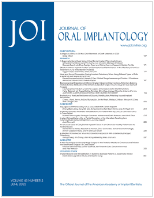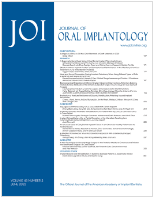[ad_1]

Journal of Oral Implantology Volume 48 Issue 3
The complicating factor for dental implant treatment in these cases is the bone health after therapeutic doses of ionizing radiation
LAWRENCE, Kan. (PRWEB)
September 01, 2022
Journal of Oral Implantology – Oral cancer can have a detrimental impact on a patient’s quality of life, causing issues with jaw structure, chewing, eating, and overall discomfort. Severe forms of cancer, such as adenoid cystic carcinoma (ACC)—a rare form of salivary gland malignancy that can spread to the breast, skin, respiratory system, and reproductive organs—create major complications for dental health practitioners due to the aggressive nature of the cancer therapies. ACC treatment plans typically involve surgery and radiotherapy which weaken the jaw and lead to malformation, caries, and lost teeth.
“The complicating factor for dental implant treatment in these cases is the bone health after therapeutic doses of ionizing radiation,” pens Tirakhsh Emadi, DDS, out of a private practice in Dallas, Texas, as well as co-authors from Nova Southeastern University College of Dental Medicine, Davie, Florida. Emadi and colleagues recently published a novel case report in the Journal of Oral Implantology that outlines the successful implant rehabilitation after partial removal of the mandible due to ACC.
A 57-year-old Black woman presented with an inability to eat, open her mouth widely, and extreme discomfort in her mandibular teeth. The patient received a combination of multiple oral surgeries for tumor removals and radiotherapy from being diagnosed at age 24 with ACC, then again with recurring diagnoses and similar treatments at ages 34 and 47. Given the patient’s extensive surgical history and radiotherapy, the treatment plan included removal of the remaining teeth, dental implant insertions, and a removable prosthesis in the mandibular arch, requiring substantial oral rehabilitation.
Before beginning treatment, consultation with a radiation oncologist was imperative to ensure radiation exposure did not spread throughout the mandible and that there was enough solid bone to move forward. The patient’s treatment plan was verified and began with one tooth extraction and implant placement. The healing process yielded no complications, and treatment proceeded with removing the subsequent teeth and implant placements. The placement of the removable prosthesis occurred after a three-month rehabilitation period. The patient had a follow-up appointment three months later with imaging showing proper healing, and “the patient reported that she was so satisfied with the mandibular rehabilitation, that she kept the prosthesis in place even during sleep since it stabilized her mandible for all-day and all-night comfort.”
This case report shows that oral cancers, especially aggressive and recurring cancers like ACC, can harm a patient’s quality of life. However, successful reconstructive surgery is possible with appropriate collaborative care and a thorough understanding of the patient’s history. Regarding the importance of this case report, co-author Jack Piermatti, DMD, states that “it highlights the topic of oral malignancy and the restoration of comfort and function for patients. Although this article features a case of ACC of the submandibular salivary gland, any malignancy involving the oral and maxillofacial area can be devastating for the patient. After complete removal of the lesion and surgical reconstruction of the mandible, prosthodontic specialists can combine disciplines of implantology and prosthetic restoration for the return of a satisfactory quality of life for patients with these malignancies.”
Full text of the article, “Implant Rehabilitation After a Partial Resection of the Mandible Resulting from Submandibular Gland Malignancy—A Case Report” Journal of Oral Implantology, Vol. 48, No. 3, 2022, is available at https://doi.org/10.1563/aaid-joi-D-21-00086
###
About the Journal of Oral Implantology
The Journal of Oral Implantology is the official publication of the American Academy of Implant Dentistry and of the American Academy of Implant Prosthodontics. It is dedicated to providing valuable information to general dentists, oral surgeons, prosthodontists, periodontists, scientists, clinicians, laboratory owners and technicians, manufacturers, and educators. The JOI distinguishes itself as the first and oldest journal in the world devoted exclusively to implant dentistry. For more information about the journal or society, please visit http://www.joionline.org.
Media Contact:
Samantha Weinkauf
Allen Press, Inc.
785/865-9123
sweinkauf@allenpress.com
Share article on social media or email:
[ad_2]

